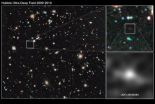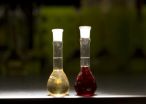(Press-News.org) Astronomers have pushed the NASA/ESA Hubble Space Telescope to its limits by finding what is plausibly the most distant and ancient object in the Universe [1] ever seen. Its light has travelled for 13.2 billion years to reach Hubble [2], which corresponds to a redshift around 10. The age of the Universe is 13.7 billion years.
The dim object, called UDFj-39546284, is likely to be a compact galaxy of blue stars that existed 480 million years after the Big Bang, only four percent of the Universe's current age. It is tiny. Over one hundred such mini-galaxies would be needed to make up our own galaxy, the Milky Way.
This galaxy would be more distant than the population of redshift 8 galaxies recently discovered in the Hubble Ultra Deep Field, including the current most distant spectroscopically confirmed [3] record holder at a redshift of 8.6 (eso1041 - http://www.eso.org/public/news/eso1041/), and the redshift 8.2 gamma-ray burst from 2009 (eso0917 - http://www.eso.org/public/news/eso0917/). A redshift of z = 8.6 means that the object is seen as it was around 600 million years after the Big Bang.
"We're seeing huge changes in the rate of star birth that tell us that if we go a little further back in time we're going to see even more dramatic changes," says Garth Illingworth of the University of California at Santa Cruz.
The astronomers were surprised, as this new result suggests that the rate at which galaxies were forming stars grew precipitously, increasing by a factor of ten over the 170 million years that elapsed between the era of this newly discovered candidate galaxy and that of the population of previously identified galaxies at a redshift around 8 (650 million years after the Big Bang).
"These observations provide us with our best insights yet into the likely nature of the earlier generation of primeval objects that we are yet to find," adds Rychard Bouwens of Leiden University in the Netherlands.
Astronomers don't know exactly when the first stars appeared in the Universe, but every step further from Earth takes them deeper into the early Universe's formative years when stars and galaxies were just beginning to emerge in the aftermath of the Big Bang [4].
"We're moving into a regime where there are big changes afoot. Another couple of hundred million years back towards the Big Bang, and that will be the time when the first galaxies really are starting to build up," says Illingworth.
Bouwens and Illingworth are reporting the discovery in the 27 January issue of the British science journal Nature.
The even more distant proto-galaxies that the team expects are out there will require the infrared vision of the NASA/ESA/CSA James Webb Space Telescope (JWST), which is the successor to Hubble. Planned for launch later this decade, JWST will provide the spectroscopic measurements that will confirm today's report of the object's tremendous distance.
A year of detailed analysis was required before the object was identified in the Hubble Ultra Deep Field — Infrared (HUDF-IR) data taken in the late summers of 2009 and 2010. The object appears as a faint dot of starlight in the Hubble exposures, and although its individual stars can't be resolved by Hubble, the evidence suggests that this is a compact galaxy of hot stars that first started to form over 100-200 million years earlier, from gas trapped in a pocket of dark matter.
The proto-galaxy is only visible at the longest infrared wavelengths observable by Hubble. This means that the expansion of the Universe has stretched and thereby reddened its light more than that of any other galaxy previously identified in the HUDF-IR, taking it to the very limit that Hubble can detect. JWST will go deeper into infrared wavelengths and will be at least an order of magnitude more sensitive than Hubble, allowing it to hunt more efficiently for primeval galaxies at even greater distances, at earlier times, closer to the Big Bang.
INFORMATION:
Notes
The Hubble Space Telescope is a project of international cooperation between ESA and NASA.
[1] The international team of astronomers in this study consists of R. J. Bouwens (Leiden University and University of California, Santa Cruz), G. D. Illingworth (University of California, Santa Cruz), I. Labbe (Carnegie Observatories), P. A. Oesch (ETH Zurich), M. Trenti (University of Colorado), C. M. Carollo (ETH Zurich), P. G. van Dokkum (Yale University), M. Franx (Leiden University), M. Stiavelli (Space Telescope Science Institute), V. González (University of California, Santa Cruz), D. Magee (University of California, Santa Crux) and L. Bradley (Space Telescope Science Institute)
[2] Astronomers plumb the depths of the Universe, and probe its history, by measuring how much the light from an object has been stretched by the expansion of space. This is called the redshift value or z. In general, the greater the observed z value for a galaxy, the more distant it is in time and space, as observed from our position in the Milky Way. Before Hubble was launched, astronomers could only see galaxies out to a z of approximately 1, corresponding to an era halfway through the history of the Universe. The original Hubble Deep Field, taken in 1995, leapfrogged to z = 4, or roughly 90 percent of the way back to the beginning of time. The Advanced Camera for Surveys (ACS) produced the Hubble Ultra Deep Field of 2004, pushing back the limit to z ~ 6. ACS was installed on Hubble during Servicing Mission 3B in 2002. Hubble's first infrared camera, the Near Infrared Camera and Multi-Object Spectrometer reached out to z = 7. The Wide Field Camera 3 (WFC3) first took us back to z ~ 8, and has now plausibly penetrated back for the first time to z = 10. The James Webb Space Telescope is expected to extend this back to a z of approximately 15, 275 million years after the Big Bang, and possibly beyond. The very first stars may have formed between z's of 30 and 15.
[3] Likely candidates for distant galaxies can be identified and have their redshift estimated by carefully studying them in Hubble images taken through a range of different filters. The galaxy will be visible only in some of the filters. An estimate of the redshift can be deduced from the colour of the last filter in which the object is detected (a technique known as photometric redshift). However, redshifts can only be confirmed through spectroscopic study, in which the light from a galaxy is split into its constituent wavelengths for analysis. This newly discovered candidate galaxy is too faint to be studied spectroscopically by any telescope in operation today, but the forthcoming NASA/ESA/CSA James Webb Space Telescope will be equipped to do so.
[4] The hypothesised hierarchical growth of galaxies — from stellar clumps to majestic spirals and ellipticals — didn't become evident until the Hubble Space Telescope Deep Field exposures. The first 500 million years of the Universe's existence, from a z of 1000 to 10 is now the missing chapter in the story of the hierarchical growth of galaxies. It's not clear how the Universe assembled structure out of a darkening, cooling fireball of the Big Bang. As with a developing embryo, astronomers know there must have been an early period of rapid changes that would set the initial conditions which made the Universe of galaxies what it is today.
Image credit: NASA, ESA, G. Illingworth (University of California, Santa Cruz), R. Bouwens (University of California, Santa Cruz, and Leiden University) and the HUDF09 Team
Links
- Science paper: http://www.spacetelescope.org/static/archives/releases/science_papers/heic1103.pdf
- NASA press release: http://hubblesite.org/news/2011/05
- Hubble Ultra Deep Field – Infrared: http://www.spacetelescope.org/images/heic0916a/
- Images of Hubble: http://www.spacetelescope.org/images/archive/category/spacecraft/
Contacts
Garth Illingworth
University of California
Santa Cruz, USA
Tel: +1-831-459-2843
Email: gdi@ucolick.org
Rychard Bouwens
Leiden University and University of California
Leiden and Santa Cruz, USA and Netherlands
Tel: +1-831-459-5276
Email: bouwens@ucolick.org
Oli Usher
Hubble/ESA
Garching, Germany
Tel: +49-89-3200-6855
Email: ousher@eso.org
Ray Villard
Space Telescope Science Institute
Baltimore, USA
Tel: +1-410-338-4514
Email: villard@stsci.edu
Hubble finds a new contender for galaxy distance record
2011-01-27
ELSE PRESS RELEASES FROM THIS DATE:
Shockable cardiac arrests are more common in public than home
2011-01-27
Cardiac arrests that can be treated by electric stimulation, also known as shockable arrests, were found at a higher frequency in public settings than in the home, according to a National Institutes of Health-funded study appearing in the Jan. 27 issue of the New England Journal of Medicine.
The study compared home and public cardiac arrests under various scenarios. For example, the study considered whether bystanders or emergency medical services (EMS) personnel witnessed the cardiac arrest, and whether the person experiencing the arrest received treatment with an automatic ...
Hubble sees farther back in time than ever before
2011-01-27
Pasadena, CA— Astronomers have pushed NASA's Hubble Space Telescope to it limits by finding what they believe to be the most distant object ever seen in the universe—at a distance of 13.2 billion light years, some 3% of the age of universe. This places the object roughly 150 million light years more distant than the previous record holder. The observations provide the best insights yet into the birth of the first stars and galaxies and the evolution of the universe. The research is published in the 27th January edition of Nature.
The dim object is a compact galaxy made ...
NASA's Aqua Satellite sees Tropical Depression Anthony heading toward Australia
2011-01-27
NASA's Aqua Satellite captured a visible image of the former Tropical Storm Anthony, now weakened to a tropical depression, but forecasters aren't counting Anthony out yet. Despite its weakened condition Anthony continues to move west toward Queensland, Australia and into a more favorable area for sustaining a tropical cyclone.
The Atmospheric Infrared Sounder (AIRS) instrument that flies aboard NASA's Aqua satellite captured a visible image on Jan. 26 at 03:23 UTC of Tropical Depression Anthony in the South Pacific Ocean. The image revealed a cloud-filled center of the ...
NASA's TRMM Satellite sees TD10S strengthen into Tropical Storm Bianca
2011-01-27
The life of a cyclone is a complex one, and NASA satellites have kept track of a low that has now become Tropical Storm Bianca just off the northern coast of Western Australia.
What began as a low pressure system designated as System 98S on January 24, brought rains near Kuri Bay, Australia. On January 25, System 98S strengthened into the tenth tropical depression of the Southern Pacific Ocean hurricane season and was designated as "10S." Today, January 26, that low intensified into a tropical storm and was named Bianca.
NASA's Tropical Rainfall Measuring Mission (TRMM) ...
Gender and hygiene: Could cleanliness be hurting girls?
2011-01-27
CORVALLIS, Ore. – Little girls growing up in western society are expected to be neat and tidy – "all ribbon and curls" – and one researcher who studies science and gender differences thinks that emphasis may contribute to higher rates of certain diseases in adult women.
The link between increased hygiene and sanitation and higher rates of asthma, allergies and autoimmune disorders is known as the "hygiene hypothesis" and the link is well-documented. Yet the role of gender is rarely explored as part of this phenomenon.
Oregon State University philosopher Sharyn Clough ...
Food-borne bacteria causes potentially fatal heart infection
2011-01-27
Researchers at the University of Illinois at Chicago College of Medicine have found that particular strains of a food-borne bacteria are able to invade the heart, leading to serious and difficult-to-treat heart infections.
The study is available online in the Journal of Medical Microbiology.
The bacteria Listeria monocytogenes is commonly found in soft cheeses and chilled ready-to-eat products. For healthy individuals, listeria infections are usually mild, but for susceptible individuals and the elderly, infection can result in serious illness, usually associated with ...
President Obama calls for increased investment in science, including biomedical research
2011-01-27
Bethesda, MD - Last night, in his State of the Union address, President Barack Obama presented the nation with a vision of a better future through investment in education, infrastructure, and research. Recognizing the role that innovation has played in this nation's history and the promise that it holds for addressing the many challenges we face, he stated that "maintaining our leadership in research and technology is crucial to America's success."
William T. Talman, MD, President of the Federation of American Societies for Experimental Biology (FASEB) responded, "we ...
ONR, Marine Corps show alternative energy use at forward operating bases can save dollars, lives
2011-01-27
ARLINGTON, Va.--To cut down on convoys trucking fuel to forward operating bases, as well as implement the Department of the Navy's vision for energy efficiency, the Office of Naval Research (ONR) and elements within the Marine Corps have successfully demonstrated their goal to reduce petroleum and energy usage in remote locations in Afghanistan.
"The early results from the front indicate the ability of ONR and its Marine Corps partners to make a difference in survivability and efficiency for our warfighters," said Rear Adm. Nevin Carr, chief of naval research.
"We ...
Non-alcoholic energy drinks may pose 'high' health risks
2011-01-27
COLLEGE PARK, Md. – Highly-caffeinated energy drinks – even those containing no alcohol – may pose a significant threat to individuals and public health, say researchers at the University of Maryland School of Public Health and Wake Forest University School of Medicine.
In a new online commentary in the Journal of the American Medical Association (JAMA), they recommend immediate consumer action, education by health providers, voluntary disclosures by manufacturers and new federal labeling requirements.
"Recent action to make pre-mixed alcoholic energy drinks unavailable ...
Chemists turn gold to purple -- on purpose
2011-01-27
Professor Richard Watt and his chemistry students suspected that a common protein could potentially react with sunlight and harvest its energy – similar to what chlorophyll does during photosynthesis.
The story of how they proved it sounds as colorful as the legend of the leprechaun who hid his pot of gold at the end of the rainbow.
They started with citric acid from oranges and mixed it with the protein. Next they dissolved gold powder into the solution. Then they put vials of the yellow-colored mixture in direct sunlight and crossed their fingers in the hope that ...






